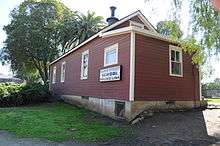Mary Chase Walker

Mary Chase Walker Morse (1828–1899) was an American schoolteacher, pioneer, and suffragette. In 1865 she became the first school teacher at Mason Street Schoolhouse, the first public school to be built in in San Diego County, California. She recorded her Recollections of Early Times in San Diego in 1898.
Early life
Walker was born in 1828, in Methuen, Massachusetts. At age 15 she worked as a teacher in Groton, New Hampshire where she taught at a district school, boarding with families in the community. Her initial salary was $4. It increased substantially, to $400, after Walker graduated from State Normal School in Framingham, Massachusetts in 1861. Her pay was soon cut in half due to the outbreak of the American Civil War.[1][2]
Teaching career and controversy

In April 1865, Walker left New York by steamer to travel to San Francisco, looking to find work.[1] She suffered from sea sickness during the trip.[2] When she disembarked in San Francisco, Walker was told that there was only a position for her in San Diego. When she arrived on July 5, 1865, Mason Street schoolhouse had just been built, and she served as its first teacher. She was paid $65 a month.[2][1][3] The Mason Street schoolhouse was the first public school to be built in in San Diego County, California.[4][5] The school had just 35 students from 4 to 17, who were taught in the same classroom.[6] Walker recalled: "My school was composed mostly of Spanish and half-breed children with a few English and several Americans. Many American soldiers and some sailors had come to San Diego in the early days and married pretty senoritas".[7]
After an 11 month term at Mason Street, she became involved in a controversy. It became known as the "Walker Incident".[2] Walker met a stewardess who had helped her when she was seasick on the steamer, and invited her to eat lunch together at the Franklin House. The stewardess has been various described as black,[1] of mixed racial origin, or quadroon.[8] This led to people walking out in disgust.[1] Many of her students' parents considered her actions improper, and boycotted her classroom.[9] Though she was forced to resign, the school trustees remained divided in their opinion of her conduct, and she grew close to senior trustee Ephraim Morse, whom she married on December 20, 1866.[9]
Later life, death and legacy
After retirement from teaching, Walker did much work towards the suffragette movement and helping impoverished people.[1] In 1898, the year before her death, she published a paper entitled Recollections of Early Times in San Diego.[10] She died on May 17, 1899.[1]
On October 16, 1972, Mary Chase Walker Elementary School, on Hillery Drive in Mira Mesa, California opened in her honor.[11] Estelle Lauer, vice president for programs at San Diego Historical Society said of her in 2014: "She bridged America east and west, as well as past and present. As an emigrant American, she is an ideal figure for this season’s lecture theme, Coming to California: The Immigrant Experience."[12]
Notes and references
Notes
- 1 2 3 4 5 6 7 "Mary Chase Walker (1828-1899)". San Diego History Center. Retrieved 9 October 2016.
- 1 2 3 4 Cohen & Harris 2016, p. 13.
- ↑ San Diego Magazine. CurtCo/SDM LLC. July 2006. p. 1. ISSN 0036-4045.
- ↑ "Life in 1865 at Old Town's Mason Street School". Cool San Diego Sights. Retrieved 7 November 2016.
- ↑ "Mason Street School- San Diego's First Schoolhouse - San Diego, California - First of its Kind". Waymarking.com. Retrieved 7 November 2016.
- ↑ "Rotation 2: Life in San Diego 100 Years Ago:Mary Chase Walker" (PDF). Parks.sandi.net. Retrieved 9 October 2016.
- ↑ Engstrand 2005, p. 84.
- ↑ Harrison, Donald H. "San Diego's Historic Places: Mason Street School". San Diego Jewish World. Retrieved 7 November 2016.
- 1 2 Cohen & Harris 2016, p. 15.
- ↑ Cohen & Harris 2016, p. 16.
- ↑ Stevens 2011, p. 38.
- ↑ "Mary Chase Walker, first San Diego schoolteacher, brought back to life in talk". San Diego Times. 3 March 2014. Retrieved 9 October 2016.
References
- Engstrand, Iris Wilson (2005). San Diego: California's Cornerstone. Sunbelt Publications, Inc. ISBN 978-0-932653-72-7.
- Cohen, Hannah S.; Harris, Gloria G. (21 November 2016). Remarkable Women of San Diego: Pioneers, Visionaries and Innovators. Arcadia Publishing. ISBN 978-1-4671-1826-2.
- Stevens, Pam (2011). Mira Mesa, California. Arcadia Publishing. ISBN 978-0-7385-8203-0.
Further reading
- Morse, Mary C. (July 1961). "Old Town Memories". San Diego History Journal. 7 (3): 36–38.
- Schwartz, Henry (March 1973). "The Mary Walker Incident: Black Prejudice in San Diego, 1866". San Diego History Journal. 19 (2): 14–20.
- Bongartz, Roy (6 May 1973). "Old San Diego: The Past in Present Tense". The New York Times.
- Ribbel, Arthur (15 September 1985). "The lessons were tough for San Diego's first teacher". The San Diego Union. p. G-2.
- Ribbel, Arthur (10 December 1989). "San Diego teacher rose above racial bigotry". The San Diego Union. p. G-10.
- "Guide to the Ephraim W. Morse Papers MS 144". San Diego History Center.
- "The Schoolhouse Museum" (PDF). California State Parks.